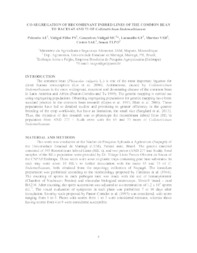Co-segregation of recombinant inbred lines of the common bean to races 65 and 73 Colletotrichum lindemuthianum.
Co-segregation of recombinant inbred lines of the common bean to races 65 and 73 Colletotrichum lindemuthianum.
Author(s): PELEMBE, A. E.; VIDIGAL FILHO, P. S.; GONÇALVES-VIDIGAL, M. C.; LACANALLO, G. F.; MARTINS, V. S. R.; CASTRO, S. A. L.; SOUZA, T. L. P. O. de
Summary: The common bean (Phaseolus vulgaris L.) is one of the most important legumes for direct human consumption (Lin et al. 2008). Anthracnose, caused by Colletotrichum lindemuthianum is the most widespread, recurrent and devastating disease of the common bean in Latin America and Africa (Pastor-Corrales and Tu 1989). The genetic mapping is carried out using segregating populations. Obtaining segregating populations for genetic mapping have been standard practice in the common bean research (Gepts et al. 1993; Blair et al. 2006). These populations have led to detailed studies and promising to greater efficiency in the genetic breeding of the crop worldwide, but have as limitation, the small size (Sanglard et al. 2013). Thus, the objective of this research was to phenotype the recombinant inbred lines (RIL?s) population from AND 277 × Rudá cross with the 65 and 73 races of Colletotrichum lindemuthianum.
Publication year: 2017
Types of publication: Journal article
Unit: Embrapa Rice & Beans
Observation
Some of Embrapa's publications are published as ePub files. To read them, use or download one of the following free software options to your computer or mobile device. Android: Google Play Books; IOS: iBooks; Windows and Linux: Calibre.
Access other publications
Access the Agricultural Research Database (BDPA) to consult Embrapa's full library collection and records.
Visit Embrapa Bookstore to purchase books and other publications sold by Embrapa.

